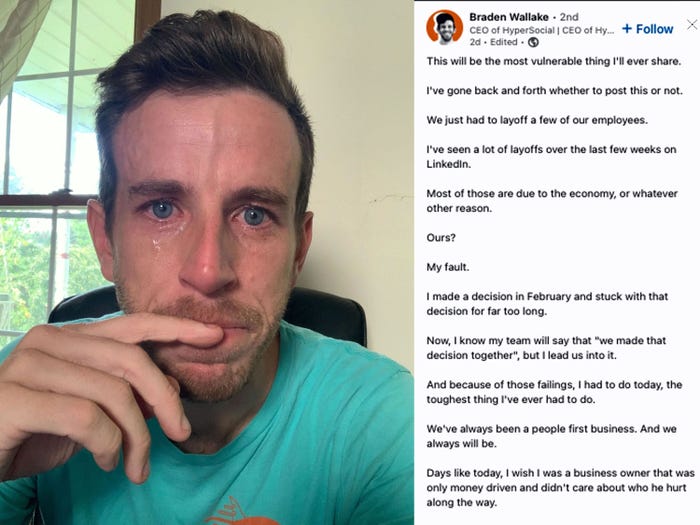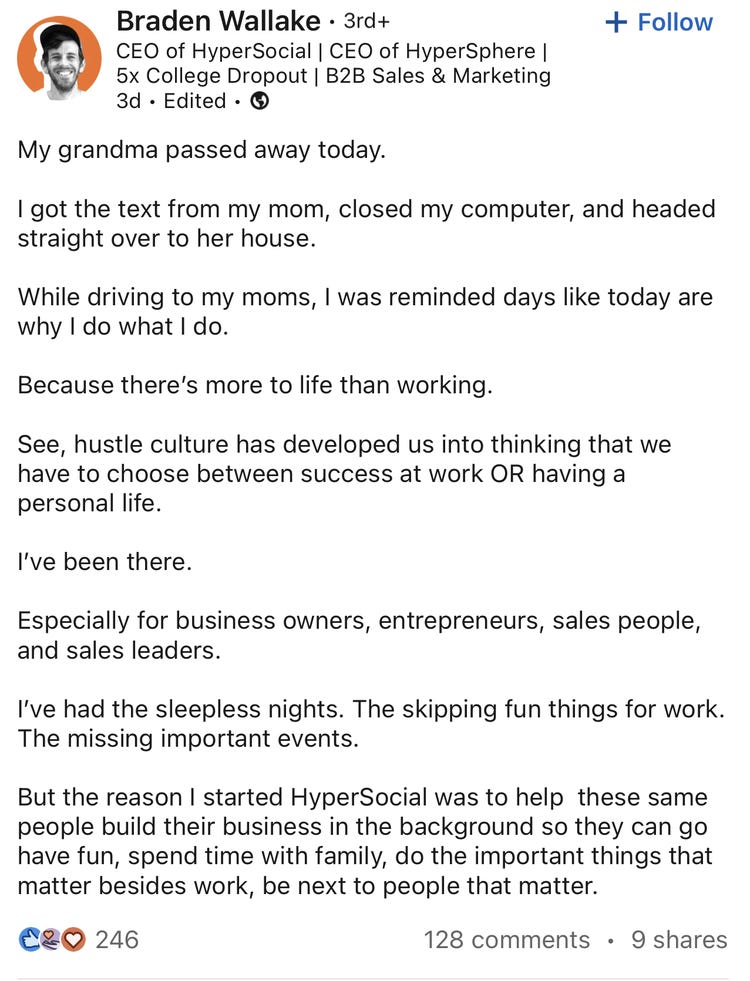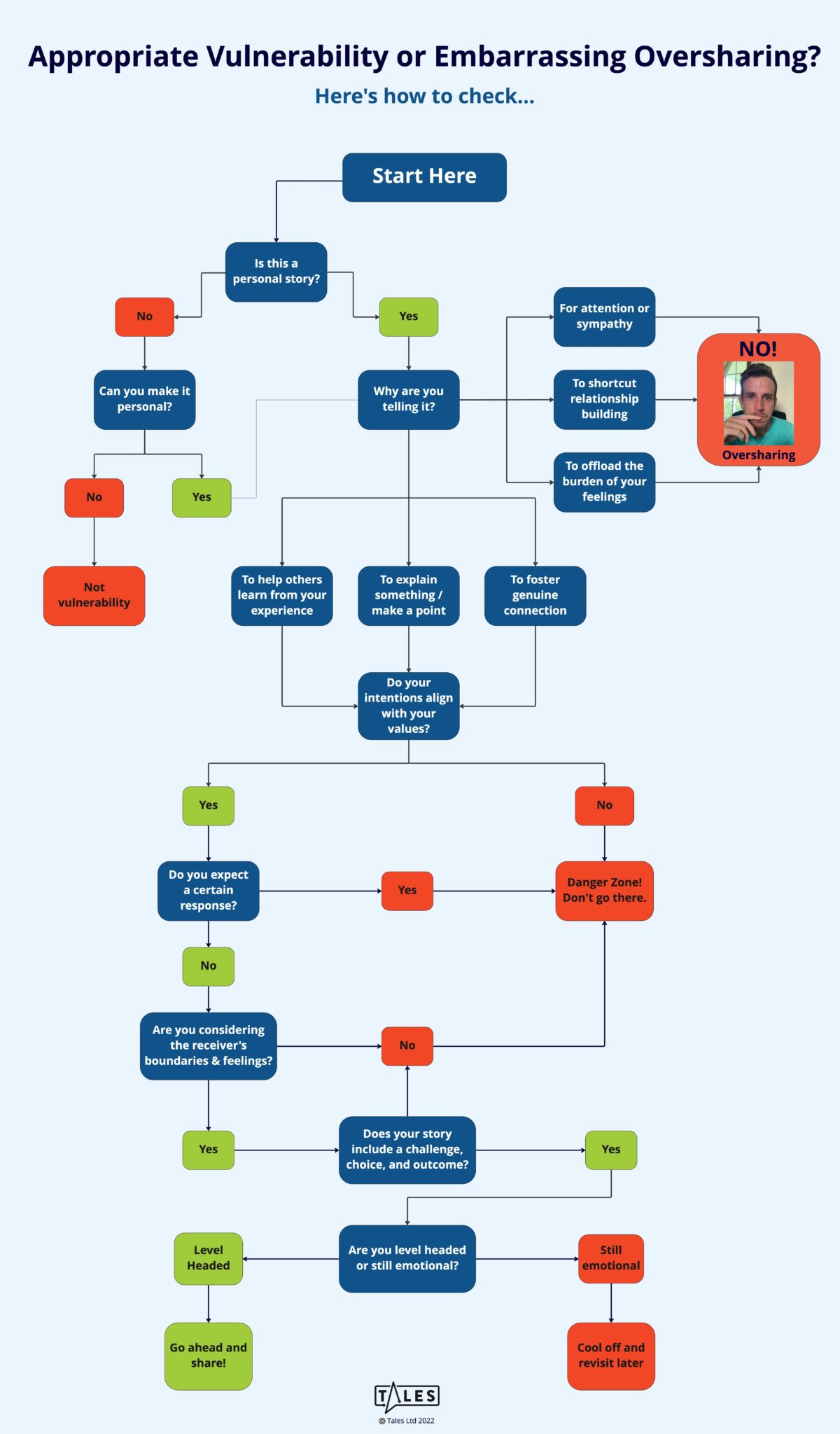Vulnerability in brand storytelling is often lauded for its ability to humanise your content, connect with your customers, and build trust on a deeper level. Yet even the thought of it makes many business leaders squirm.
Because most of us don’t know how to be vulnerable in a professional context. We associate vulnerability with weakness, oversharing, attention seeking, or telling out of context personal stories. All if which can be detrimental to your professional credibility and reputation.
But that’s not what effective vulnerability looks like at all! Showing vulnerability in a professional context is about leading with transparency and being authentic in your content and communications.
In this article, we’re going to look at what effective vulnerability looks like for tech leaders, and give you a fool proof way of gauging whether you’re on the mark (or at risk of splurging).
But before we dive in, let’s take a quick look at why you should even bother, and how showing vulnerability is an essential requirement in modern B2B marketing.
Why vulnerability matters in GEOSPATIAL marketing
The rise of social media and content marketing have vastly democratised audience reach in recent years, and brands who want to remain competitive need to keep up. Whether it’s with ad blockers, email spam boxes, or paying for ad-free streaming, our modern customers are incredibly effective at filtering out any unwanted brand communication.
So to reach our customers in 2024, we can’t simply buy their attention. We need to earn it by giving them something they genuinely want to consume. And one of the best ways to do that is through brand storytelling, which helps you attract and hold your audience’s attention like no other form of communication can.
Because it’s a dialogue – a human to human interaction. (Instead of a cold, top-down sales pitch.) And when you do it right, your customers can relate to what you’re saying. They feel like you “get” them, which fosters a sense of connection and builds trust. And if you say enough relatable stuff over time, that connection becomes a relationship and that relationship leads to a sale.
But here’s the catch: Many B2B brands don’t do it right. (Far from it!)
Because they’re afraid to get personal. In other words, they’re afraid of being vulnerable. So instead of tapping into transformative storytelling – with a character, plot and conclusion – they opt for transactional storytelling – which is basically recounting a series of chronological events and passing it of as a “story”. Unsurprisingly, these “stories” tend to flop, because nobody cares about a series of events.
People care about people. They care about stories about people. They care about emotions, feelings, conflicts, losses, wins, and triumphs. Those are the qualities that make a story interesting, but they require vulnerability. So vulnerability is the secret sauce in effective brand storytelling.
Without vulnerability, there is no story
In fact, I’d go so far as to say that without vulnerability, there is no story. Because a story isn’t actually about watching a character go through a series of events to reach an outcome. It’s about watching a character transform into someone who can successfully navigate the plot they’ve been tossed into.
And that transformation involves overcoming inner conflict, emotions, struggles… All the stuff many people hate talking about because it feels too vulnerable. But that’s the key to making your stories engaging because that’s what triggers empathy in your audience. Which, in turn, kicks off a series of psychological events that ends in the desire for your product or service.
Here’s how it works:

Basically, once your audience can empathetically relate to your character, they project themselves into the story, and viscerally experience what it would feel like to navigate this plot and experience transformation themselves. And that imagined experience, increases their desire for the real deal. So by the time you get to your lesson or conclusion, your audience has been on the journey with you and now they want it too. Which is an incredibly powerful mechanism for your business, for your sales… marketing.. or for building influence in general.
But the key to making it work is really pulling back the curtain a little and giving people something human to relate to. Which feels vulnerable, and can land you in hot water if you go too far. Because there’s a thin line between appropriate professional vulnerability and oversharing. So let’s look at where that line in the sand is, and how to be vulnerable without risking your professional credibility or reputation.
Vulnerability vs Oversharing
Most of us have been on the receiving end of professional oversharing at some stage, which can make us feel anything ranging from mildly awkward, to incredibly put off. More often than not, oversharing places unreasonable expectations on the receiver, which isn’t what we sign up for in our professional communications. These expectations range from emotional support and care taking, to sympathy or attention seeking, or an attempt to fast-track the relationship building process. All of which feels fake and “icky” for the receiver.
A perfect example of this was the crying CEO saga on LinkedIn in August, where HyperSocial CEO Braden Wallake posted a crying selfie of himself captioned “This will be the most vulnerable thing I’ll ever share…” Followed by a self-serving pity party.

People were rightly outraged at the post because it violated the premise of vulnerability by using it as a tool for a self-serving agenda. And it wasn’t a once-off offending. In another post shortly after, the same CEO used the death of his grandma to garner some sympathy points….

This kind of oversharing might get attention, but it won’t build likability and trust. And those are the foundations on which proper relationships are built. The kind of relationships that lead to sales, brand awareness, and brand equity.
In her book Daring Greatly, vulnerability researcher Brené Brown writes, “Using vulnerability is not the same thing as being vulnerable; it’s the opposite.” Which means if you’re using vulnerability as a tool for whatever ulterior motive – like to shortcut connection, elicit pity or sympathy, or gain attention – it feels icky and makes people uncomfortable.
Whereas genuine and authentic vulnerability, with the appropriate boundaries and a healthy dose of empathy for your audience, leads to deeper and more meaningful relationships that ultimately drive sales. So the million dollar question is how do you find that sweet spot? How can you be vulnerable without oversharing?
How to be vulnerable without oversharing
The main difference between vulnerability and oversharing boils down to the intention behind it.
So when you’re figuring out what side of the vulnerability/oversharing fence a certain piece of information or story falls on, ask yourself whether you’re trying to help others by sharing your experience.
Is there a clear and immediate lesson they can apply? Or are you hoping to gain sympathy or pity points? Like the crying CEO. Or perhaps trying to fast track a relationship without building trust first? Like pouring your guts out on a professional coffee date.
Another consideration is whether you’re still too hot headed or emotional to share a certain story. Many people use social media as a place to vent or blow off steam, which almost always leads to oversharing. Because over sharers tend to relieve their stress by placing it on others. And maybe that’s what crying CEO was doing. Maybe his posts weren’t engineered for attention but a way for him to make sense of his situation. But they were nonetheless inappropriate.
Because truly vulnerable people tolerate their pain or anxiety and carefully consider whether it’s good idea to share something. Whether there’s a valuable lesson contained in the story or if it’s something best dealt with in private. And if they do choose to share, they carefully consider how to make the story about that lesson, instead of just having a rant.
So although there’s nothing wrong with sharing feelings (quite the opposite), we still need to carefully consider what we’re sharing and more importantly WHY.
The ultimate guide to vulnerability flowchart
To help you navigate this tightrope walk, and have a fool proof way of gauging whether a story or piece of information is appropriate to share or perhaps not, we’ve developed a flow chart that covers what to share, why, and how.
Let’s take a look and walk through the steps together…

Start with WHAT you want to share
At the top we start with what. What is it you want to share? And there’s really only one right answer here, which is a personal story.
You can’t really share something vulnerable about another person, because exposing someone else is not vulnerability. You also can’t share something vulnerable on behalf of a brand, because exposing a non-human entity is also not vulnerability.
The only thing that qualifies as vulnerability is pulling back the curtain to give people a glimpse into your own life or inner world. So if you want to share a vulnerable story about someone else or a brand, see if you can turn it into a personal story that matters to your audience.
Then, ask yourself WHY you want to share it
Once you’re clear on the what – and it’s a relatable personal story – it’s time to look at the why. Why are you sharing it? To make sure your reasoning aligns with your brand values and goals, ask yourself
- What outcome am I hoping for?
- Do my intentions align with my values?
- Is there an outcome, response, or lack of a response that will hurt my feelings?
- Do my expectations take into account the other person’s boundaries and preferences?
And use your answers to gauge whether your story is helpful and appropriate. For example, had the crying CEO asked himself what outcome he was hoping for, I’m guessing his answer would have been something like “to go viral.” Which he obviously achieved. But did he consider how his intentions align with his values? How that reflects on him and his brand? How he’s impacting the feelings and personal boundaries of the people he let go? Probably not.
So be real with yourself here, and make sure your intentions align with your values and that you’re prepared to back yourself one hundred percent.
And if whatever you want to share passes that test, and you’re confident that it’s appropriate for you and your audience, then the next thing to consider is HOW to package it in a useful way. So that we avoid well-intentioned sharing where the delivery misses the mark landing you back in the awkward zone.
And, lastly, consider HOW you’re going to share it
So for an effective delivery, ask yourself, “is there a clear challenge, choice, and outcome?”
Because those are the three key ingredients of a powerful story. Where the hero (character), faces a challenge, navigates the plot by making a number of choices, to reach his ultimate outcome (transformation) So by using this question as a vulnerability filter, you ensure that your story zeros in on the things that matter.
And if you have those three ingredients, you can dig a bit deeper and make your story even better by asking yourself:
- What emotions does the challenge evoke? (By talking about emotions your audience can relate to, you create emotional resonance)
- Which values are expressed through the choice? (Make sure they are values you want to be associated with, and values your audience can relate to)
- What lesson does the outcome teach? (If there’s no immediately relevant lesson for your audience, it’s oversharing. So make it clear what the lesson is)
Only once you’ve answered all those questions and considered the implications for yourself and your audience at each step, you’re ready to share your story. Because if you’ve applied those filters, you can share with confidence and reap the benefits of vulnerability without the risk of oversharing.
If you want to build brand awareness, authority, and trust, your best bet is to start by nailing your brand story.
Whenever you are ready, there are 2 ways we can help you do that:
- Join The Storydriven Marketing Academy: Our FREE course that teaches you how to consistently nail your messaging across all brand assets
- Enquire about our Brand Storytelling Workshop: We work with you 1:1 over four guided workshop sessions to craft your storydriven brand messaging & content strategy
